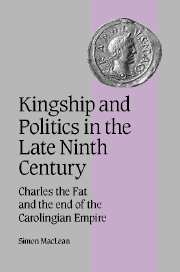 Kingship and Politics in the Late Ninth Century
Kingship and Politics in the Late Ninth Century Published online by Cambridge University Press: 15 July 2009
In the year 880, the four surviving Carolingian rulers met at Vienne to draw a line under the revolt of Boso and to seal a succession and division treaty which led to a period of renewed concord in the royal dynasty. One of their more specific goals was to make kingship more accessible to the nobility of Lotharingia, the symbolically and strategically important central Frankish realm which had been thrown into renewed turmoil by the events of 879. In this aim, the Vienne treaty was broadly similar to most other Carolingian family settlements. The point of subkingship, for example, was not only to keep junior members of the royal house happy by allowing them a tangible share in power, but also to give provincial aristocracies their ‘own’ king, who would often be married into a local family of note. A nearby royal court was less a hindrance than a potential source of opportunity for regional aristocrats, serving as a source of offices which would help them entrench their local standing, and as a doorway leading onto the grander stage of imperial politics. Equally, the Carolingians, lacking the institutions of the decayed Roman state, needed members of the aristocracy, whose power was rooted in control of land, to act as the means of transposing their authority from the palace to the localities.
To save this book to your Kindle, first ensure [email protected] is added to your Approved Personal Document E-mail List under your Personal Document Settings on the Manage Your Content and Devices page of your Amazon account. Then enter the ‘name’ part of your Kindle email address below. Find out more about saving to your Kindle.
Note you can select to save to either the @free.kindle.com or @kindle.com variations. ‘@free.kindle.com’ emails are free but can only be saved to your device when it is connected to wi-fi. ‘@kindle.com’ emails can be delivered even when you are not connected to wi-fi, but note that service fees apply.
Find out more about the Kindle Personal Document Service.
To save content items to your account, please confirm that you agree to abide by our usage policies. If this is the first time you use this feature, you will be asked to authorise Cambridge Core to connect with your account. Find out more about saving content to Dropbox.
To save content items to your account, please confirm that you agree to abide by our usage policies. If this is the first time you use this feature, you will be asked to authorise Cambridge Core to connect with your account. Find out more about saving content to Google Drive.